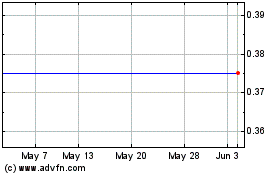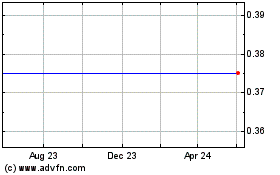Final Results -10-
March 27 2009 - 3:01AM
UK Regulatory
indicative bids from market makers. Where there is a significant or prolonged
decline in fair value of an available for sale financial asset (which
constitutes objective evidence of impairment), the full amount of the
impairment, including any amount previously charged to equity is recognised in
the income statement. Purchases and sales of available-for-sale financial assets
are recognised on trade date with any change in fair value between trade date
and settlement date being recognised in retained earnings.
f) Property, Plant and Equipment
Office equipment is stated at historical cost less depreciation. Depreciation is
calculated on a straight line method to allocate the cost over the estimated
useful life. The estimated life of office equipment is 3 years. Assets costing
less than GBP25,000 are written off on the year of acquisition.
g) Trade and other receivables
Trade and other receivables are recognised initially at fair value. A provision
for impairment is established where there is objective evidence that the Group
will not be able to collect all amounts due according to the original terms of
the receivables concerned.
h) Cash & cash equivalents
Cash and cash equivalents comprise cash at bank and in hand and short-term
deposits with an original maturity of three months or less.
i) Loans
All loans and borrowings are initially recognised at the fair value of the
consideration received net of issue costs associated with the borrowings. After
initial recognition, these are subsequently measured at amortised cost using the
effective interest method, which is the rate that exactly discounts the
estimated future cash flows through the expected life of the liabilities.
Amortised cost is calculated by taking into account any issue costs and any
discount or premium on settlement.
j) Trade and other payables
Trade and other payables are stated at amortised cost.
k) Equity instruments
Equity instruments issued by the Group are recognised at the proceeds or fair
value received with the excess of the amount received over 0.1p par value being
credited to the share premium account. Direct issue costs are deducted from
equity.
l) Revenue
Income from loans and receivables is recognised as it accrues by reference to
the principal outstanding and the effective interest rate applicable, which is
the rate that exactly discounts the estimated future cash flows through the
expected life of the financial asset to that asset's carrying value.
Fee income earned on financing arrangements that relate to investments measured
at fair value through profit or loss are recognised when that investment is
made. Fees earned from financing arrangements that relate to investments
classified as loans and receivables are recognised over the life of the assets.
Fees in respect of any ongoing services are recognised as that service is
provided.
Dividends from equity investments are recognised in the income statement when
the shareholders rights to receive payment have been established.
m) Dividends
Dividends are recognised when they become legally payable. In the case of
interim dividends to equity shareholders, this is when declared by the
Directors. In the case of final dividends, this is when approved by the
shareholders at the AGM.
n) Share-based payments
Where equity settled share options are awarded to employees, the fair value of
the options at the date of grant is charged to the consolidated income statement
over the vesting period. Non-market vesting conditions are taken into account by
adjusting the number of equity instruments expected to vest at each balance
sheet date so that, ultimately, the cumulative amount recognised over the
vesting period is based on the number of options that eventually vest. Market
vesting conditions are factored into the fair value of the options granted. As
long as all other vesting conditions are satisfied a charge is made irrespective
of whether the market vesting conditions are satisfied. The cumulative expense
is not adjusted for failure to achieve a market vesting condition.
When the terms and conditions of options are modified before they vest, the
increase in the fair value of the options, measured immediately before and after
the modification, is also charged to the consolidated income statement over the
remaining vesting period.
o) Finance expense
Interest expense is calculated using the effective interest rate method. Finance
costs are recognised in the income statement over the period of the loans and
borrowings related to those costs.
p) Foreign currency translation
Transactions entered into by group entities in a currency other the currency of
the primary economic environment in which they operate (their "functional
currency") are recorded at the rates ruling when the transactions occur. Foreign
currency monetary assets and liabilities are translated at the rates ruling at
the balance sheet date. Exchange differences arising on the retranslation of
unsettled monetary assets and liabilities are translated at the rates ruling at
the balance sheet date. Exchange differences arising on the retranslation of
unsettled monetary assets and liabilities are recognised immediately in the
consolidated income statement.
On consolidation, the results of overseas operations are translated into
sterling at rates approximating to those ruling when the transactions took
place. All assets and liabilities of overseas operations are translated at the
rate ruling at the balance sheet date. Exchange differences arising on
translation the opening assets at opening rate and the results of overseas
operations at actual rate are recognised directly in equity (the "translation
reserve").
4 Significant judgments, key assumptions and estimates
The Group's significant accounting policies are stated in note 3 above. Not all
of these significant accounting policies required management to make difficult,
subjective or complex judgements or estimates. The following is intended to
provide an understanding of the policies that management consider critical
because of the level of complexity, judgment or estimation involved in their
application and their impact on the consolidated financial statements. These
judgments involve assumptions or estimates in respect of future events. Actual
results may differ from these estimates.
a) Fair value of financial instruments
The Group determines the fair value of financial instruments that are not quoted
by using either indicative prices or valuation techniques. These indicative
prices and valuation techniques are significantly affected by the assumptions
used, including discount rates and estimates of future cash flows. In that
regard, the derived fair value estimation cannot always be substantiated by
comparison with independent markets and in many cases may not be capable of
being realised immediately.
b) Trade receivables and interest receivables on investments
The Group is required to judge when there is sufficient objective evidence to
require the impairment of individual trade receivables or interest receivables
on its investments. It does this on the basis of the age of the relevant
receivables, external evidence of the credit status of the debtor entity and the
status of any disputed amounts.
c) Legal proceedings
The Group reviews outstanding legal cases at each balance sheet date in order to
assess the need for provisions and disclosures in the financial statements. This
requires the Group's management to make determinations about various factual and
legal matters beyond its control. Among the factors considered in making
decisions on provisions are the nature of litigation, claim or assessment, the
legal process and potential level of damages in the jurisdiction in which the
litigation, claim or assessment has been brought, the progress of the case the
opinions or views of legal advisers, experience on similar cases and any
decision of the Group's management as to how it will respond to the litigation,
claim or assessment.
5 Segment reporting
The Directors consider that there is only one business segment being specialist
integrated finance and asset management and only one geographic area being
Europe.
6 Financial risk management
The Group's activities expose it to a variety of financial risks: concentration
risk, market price risk, interest rate risk, currency risk, credit risk,
liquidity risk and capital risk. The Group's overall risk management programme
focuses on the unpredictability of financial markets and seeks to minimise
potential adverse effects on the Group's financial performance.
a) Concentration risk
Concentration risk arises from individual investments to which the Group has
significant exposure. The Group defines significant exposure as 20 percent of
gross portfolio value. Concentration risk is managed through regular review of
public information and from review of reports from debt agents and similar,
where appropriate. The Group seeks to have board representation on such
investments and to communicate regularly with managers of these investments. ACP
management reports quarterly to the Board on the relevant investments.
The concentration risks at year end were:
-IFR Capital plc - the Group's exposure totaled GBP89.7 million of the net asset
value total of GBP163.6 million (2007: GBP128.8 million of GBP233.2 million)
-Leasecom Group SAS - the Group's exposure totaled GBP24.7 million of the net
asset value total of GBP163.6 million (2007: GBP24.3 million of GBP233.2
million)
b) Market price risk
Market price risk arises from uncertainty in the future value of financial
instruments. No new investments are being made. Existing investments are managed
by the investment advisor who reports regularly to the Board to review past and
expected future performance. The nature of investments is diverse. Monitoring
includes reviewing monthly and quarterly financial management reports and
ACP Capital (LSE:APL)
Historical Stock Chart
From Oct 2024 to Nov 2024

ACP Capital (LSE:APL)
Historical Stock Chart
From Nov 2023 to Nov 2024
